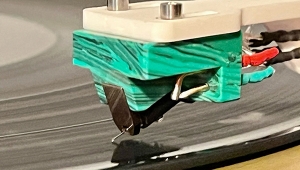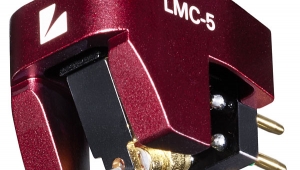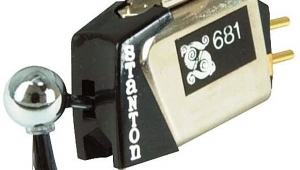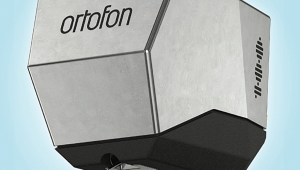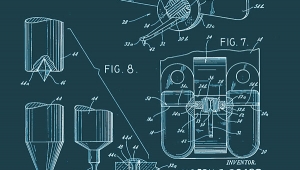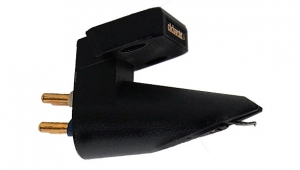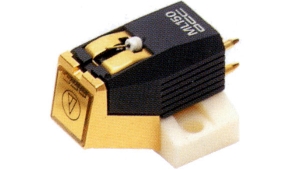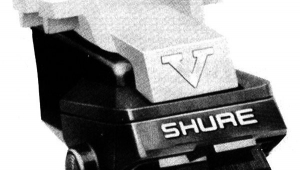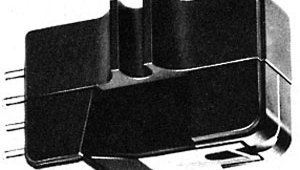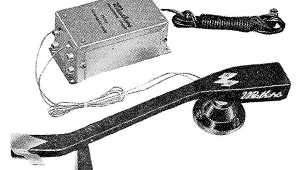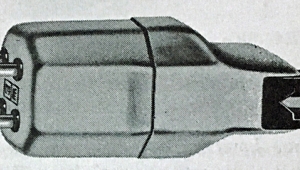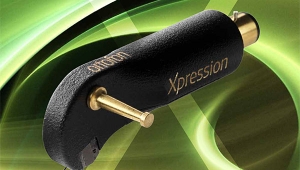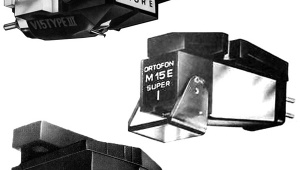| Columns Retired Columns & Blogs |
Linn Troika MC phono cartridge
Some six or so years ago, the Linn Asak cartridge set new standards for imaging and soundstage reproduction. I can remember the first time I heard an Asak in a system using Quad ESL-63s—I had never experienced such depth of soundstage and solidity of imaging from any system, and that with Quad amplification! The Asak was relatively quickly overshadowed in this area, however, and in any case, soundstaging precision by itself didn't seem to be a high priority for the Linn design team, who were apparently more concerned with dynamics and a musical integration of the sound across the frequency range.
These two aspects of cartridge performance, precision/accuracy and musicality, often seem mutually incompatible. According to Anthony Cordesman's survey in Vol.10 No.5, such cartridges as the Monster Alpha 2, Clear Audio Veritas, and Talisman Virtuoso DTi seem to maximize information retrieval and transparency, but lose out to the musical presentation of the Koetsu Signature Red, Monster Alpha Genesis, and the Linn Karma. However, like many audiophiles, I want analysis and synthesis. I want—no, I need both the maximum retrieval of information and the integration of that information in a transparent, musically believable—and stimulating—whole.
My choice of cartridges over the last ten years has reflected either one side or the other of this apparent dichotomy, as the minutiae of my system brought one or the other aspect into relief. On the detail/accuracy front, a Shure V15 IV was succeeded by first a Dynavector Ruby Karat, then a Mission high-output MC, a Technics EPC 205 MM, another Ruby Karat, a Goldbug Miss Brier, and a Dynavector Diamond Karat. Interspersed among those engines of analysis, I enjoyed a Dynavector 20B, a Denon DL103D, two Koetsu Blacks, a Linn Asak, and finally two Koetsu Reds, the last three occupying the sharp end of my system for the last four years.
When Linn introduced their metal-bodied Karma in 1985, it seemed to me to be an attempt to increase transparency and dynamic performance without losing the Asak's consistent musical quality. I never used one in my own system, but in the two systems in which I heard the Karma regularly, I was bothered by its rather upfront presentation when compared with the Asak. Certainly the Karma is a top-rank design; it was just that its view of the music was a little out of sympathy with my own. I suppose you could say that I want a little more romance and soul; Patti Labelle rather than Patti Smith.
In March of this year, however, I visited a friend in England, John Farlowe of Exposure Electronics. His PMS Isobarik system (triamped with regulated-power-supply Exposure amps) produced both a musically satisfying and incredibly detailed sound. The coherence of the musical presentation was not compromised by the detailed presentation of the soundstage. (Yes, with Isobariks, no less!) I checked out his front end: there, sitting in the end of his Ittok, in place of the Karma I had expected, was a weird, rose-colored, metal-flake-finished cartridge, fastened to the headshell with three bolts. I had had my first experience of the Troika.
Mechanical integrity of the cartridge/tonearm system has always been a major concern of the Linn design team. The Ittok tonearm, for example, was, apart from the rare Swiss Breuer, the first high-integrity tonearm, rivaled today only by the Alphason HR100S, the Rega RB300, the SME V/IV, and the no-longer-available Sumiko "The Arm." The detachable headshell and azimuth adjustment were sacrificed in the effort to maximize mechanical integrity. Similarly, the Asak's flat body top and the replacement of its plastic body by metal in the Karma and Asaka were steps toward producing the tightest, least reflective/reactive interface between cartridge and headshell.
With the Troika, Linn has pushed this idea even further, but at the expense of universal tonearm compatibility. A webbed extension of the body casting extends behind the body, and a third bolt holds this plate against the headshell. (Not entirely coincidentally, the Ittok headshell has a pilot hole at exactly the right place; it just needs reaming out with a twist drill—easier than it sounds, if you're careful.) In addition, both the standard ½" centered holes and the third hole are distinguished by having a small, raised, circular land around them, machined flat. Though it seems unlikely, Linn claims the total mating area of the three raised "washers" to be greater than the effective contact area of a conventional flat body top.
Apart from the need to enlarge the hole in the Ittok headshell, mounting the Troika presents no real problems. Care must be taken, however, that the cartridge is correctly positioned when the bolts are fully tightened, as the lands indent the undersurface of the headshell, making it difficult to reposition the cartridge if it turns out that the offset angle is incorrect.
The motor is identical to that of the Karma, and a short aluminum cantilever—Linn has consistently shied away from exotic cantilever materials—holds a high-quality nude Vital stylus. A major difference, however, is that flying leads are used rather than the usual pin/lead business, removing one set of electrical contacts from the signal path.
The sound
Auditioning took place with the Troika set up in an Ittok tonearm mounted on a 1987-spec Sondek LP12 turntable (with the new laminated armboard), the player resting on a Sound Organization table with spiked feet penetrating the carpet. The player was set up by Audiophile Systems' Sales Manager, Susan Larochelle, to ensure that all was hunky-dory. The rest of the system was my usual combination of Audio Research SP-10 II and Krell KSA-50 amplification, driving Celestion SL600 loudspeakers sitting on spiked Celestion/Foundation stands. Cartridge loading was 100 ohms.
I put on the first record; the stylus hit the groove with a clean "pop." Now I am a big believer in what that first impulsive pop—God's own step signal—reveals. Without even listening to music, you can get an impression of the excitability of the LF tonearm-mass/cartridge-compliance resonance—ie, how much bass overhang results—and to what degree the cartridge's HF response will exaggerate surface noise. The Troika seemed pretty well matched to the Ittok, with no bass sogginess to the sound of the stylus hitting the groove, and the resultant groove noise was very quiet, suggesting a good finish to the stone. Once the music started, the first impression was of a much lighter, less "romantic" balance than the Koetsu Red that had most recently occupied the sharp end of my system. Low frequencies had less weight, but there was no feeling of insufficient bass; rather, the low frequencies were "fast," with clearly delineated leading edges to transients from such bass-rich instruments as tympani and double bass. Even with a typically modern, dry, bass guitar sound—where are you Jack Casady, now that music needs you?—on Reuben Blades's Y Seis del Solar (Elektra 9 604321-1), the clarity with which the bass was presented compensated for the Latin percussion's lack of kick drum.
This transparency extended up the frequency range. Susan Larochelle had brought with her a record of Britten's two solo cello suites, Opp.72 and 80 (Decca/London SXL 6393). Recorded in 1970, the cello image (a little unstable with frequency; I suspect spaced miking) hangs convincingly between the speakers. This is not just a sterile piece of cartridge soundstaging wizardry, however. Coupled with the precise presentation of the cello's tonality—the Troika allows you to hear without ambiguity when Rostropovich plays with the bow closer to bridge than fingerboard—you are drawn inexorably into the music. When I used to play the violin, I was very much aware that the essential sweetness of string tone was set against the underlying bitter astringency of the sound of horsehair scraping against gut. This tonal contradiction, akin to the fight between tartness and sugar in a really well-made sherbet or sorbet (LA's girlfriend, Laura Chancellor, is a virtuoso sorbet/sherbet preparer), would bring a tight feeling to my throat but is something I very rarely hear from recorded solo strings, the balance shifting too far to one or the other extreme. With the Troika and this Britten recording, my throat tightened appropriately, particularly when Rostropovich played harmonics.
That the Troika is capable of virtuoso soundstage delineation was demonstrated with James Boyk's recording of Beethoven's "Pathetique" piano sonata (Performance Recordings PR-5). One of my favorite test records, it was recorded with crossed 4038 ribbon mikes and, with the best equipment, is capable of creating a soundstage between and behind the loudspeakers possessing, as the Cheapskate would put it, a "palpable presence!" And presence there was, the piano image cleanly delineated between the speakers, not occupying the full stage width, but allowing the recording venue to be discerned around it, though with a little less apparent depth than I have heard before. As with the Rostropovich recording, the tonal integrity of the Troika across the band allowed the complex interplay of harmonics in the Steinway tone to be easily resolved, without any unnecessary exaggeration of detail.
Another favorite test disc is Light Blues, a 1982 digital recording by Tony Faulkner (Hyperion A66059). The spatial locations of individual voices in this collection of unaccompanied French part songs were exquisitely defined. A slight presence-band "edge" to the sound resulted in less stage depth than I am used to, but this may be partly due with this LP to a more transparent presentation of the artifacts of the digital recording. That it was more than that was revealed with the next disc to hit the turntable, Amazing Grace (Atlantic SD 2-906). One of the most uneven live recordings ever, a marvelous sense of "being there" is offset by a consistently over-recorded Aretha Franklin. God knows what microphones were used, the applause sounding more like the congregation was banging shingles together. But no matter: forget "Who's Zooming Who?"—this is the First Lady of Soul showing why she endures while others end up in Lake Tahoe. Although I expected the rather upfront HF presentation of the Troika to make Aretha's closeness to the mike more uncomfortable than with the Koetsu's more laid-back presentation, this was not so. Yes, tonally the sound was somewhat forward, but her voice had, I don't know how else I can explain it, "clean edges." I assume this is due to the improved mechanical integrity of the three-point fixing, and was even more noticeable on an LP transfer of a collection of Fred Astaire film soundtracks from the '30s (Columbia PSG 32472).
Probably the ultimate test for a Scottish cartridge is being asked to play some quintessentially English music, Ronald Binge's The Watermill, on HMV Greensleeve ESD 7063. (You may be more familiar with Binge's '50s smash hit, Elizabethan Serenade.) The stereo image is a little pulled to the sides in this 1970 recording, but the Troika, like the Koetsu Red, doesn't exaggerate the size of the central oboe soloist when compared with the swirling cello/bass arpeggios. It remains realistically small, benefiting from the Troika's precise imaging capabilities, and string tone was nothing less than delicious, despite a slight brightness to the sound.
Conclusion
Less bass-rich than the Koetsu Red, less romantically balanced, with a more forward upper-midrange presentation, and not quite as capable of throwing as deep a soundstage, the Troika strikes an excellent balance between the analytical retrieval of fine detail and the preservation of the musical structure supported by that detail. Considerably less shrill than the traditional "high-detail" cartridges, in UK parlance it "plays tunes" across the frequency band.
If its presentation of tonality is still a little upfront—within that unusual body, it is still basically a Karma—the integration of its performance from bass to high treble enables it to compete effectively with the Koetsu for pole position in my system. Ultimately, the Japanese cartridge edges ahead—I said I'm a sucker for romance—but certainly with the Troika, Linn has again managed to produce a world-beating cartridge, even if "world-beating" must be qualified by the fact that it can only be confidently recommended for those using Ittok tonearms. The Ittok, I feel, is still distinguished by a liveliness in the upper midrange that tends to add a sheen of "excitement," particularly to voices. Nevertheless, it is an excellent platform for the Troika, and the complete 1987 Linn player—Troika, Ittok, Sondek LP12—must be ranked as among the world's best.
How does the Troika rank against the $800 Monster Alpha Genesis, which did so well in Cordesman's survey last month? For the answer to that question, you will have to wait until the next issue of Stereophile!
- Log in or register to post comments
